SZKUTA WISLANA
Or also known as the "Vistula Barge," these were large sailing and rowing boats. From the 13th to the 18th century, they were used to transport various cargo and grain along the Vistula to Gdansk. The grain was simply poured into large boxes attached to the deck, and the barge took advantage of the wind and the river's current. The paragraphs in quotation marks correspond to the article “Szkuta Wislana - Marek Zuzanski – Modelarz 1985-12”
1 History
“The barge,” as stated by the PWN Encyclopedia, “is the oldest Polish sailing boat: undecked, with sail and oar, with a very high bow and a flat stern. It can be added that it is the best described and documented Polish sailing vessel. Images of the barge can be found in many engravings and paintings depicting Polish ports in the 17th and 18th centuries. The most beautiful barges, depicted down to the smallest detail, can be seen in Schuster's engraving of 1770 and in Canaletto's painting entitled "View of Warsaw from the Prague Side," also from 1770. However, the main document that allows us to reconstruct the shape, construction, and equipment of Polish riverboats is the 1796 report by Losy von Losennau. It is an inventory of vessels containing drawings. technicians, tabular lists of unit dimensions, materials used for their construction and equipment.
The Szkuta sailed up the Vistula until the end of the 18th century. They transported various goods: barrels, crates, and timber, and after assembling special crates, they also carried bulk cargo: grain or copper ore. Statistics show that 72 percent of the ships sailing to Gdańsk between 1766 and 1770 were barges. In the first half of the 19th century, the barge was dethroned by a new type of boat: the Statku, which was more maneuverable and economical.
After the date of that article, the wreck of a Szkuta was found near Czersk in Mazovia, and thanks to the 2009 excavations, we know a lot about its construction. It consisted of a large, well-preserved barge from the 15th century. The hull was about 30 m long, 7.4 m wide, 1.45 m deep, and had a 21 m mast. It was made of oak wood, with a flat bottom and no keel. The oak strakes were 7 cm thick and 34 to 48 cm wide, bound and sealed with moss and strips of animal hair mixed with tar. Dendrochronological analysis shows that the oak used for the construction of this boat was fell in the second half of the 15th century and that the Czersk barge sailed on the Vistula for at least 60 years old. Very similar to the boat shown here. It's worth mentioning that in addition to the skipper and helmsman, this boat required up to 16 crew members to row or pull it upstream along paths, sometimes assisted by oxen or similar means.
2. References:

 zagle.se.pl
zagle.se.pl

 pl.wikipedia.org
pl.wikipedia.org

 pl.wikipedia.org
pl.wikipedia.org
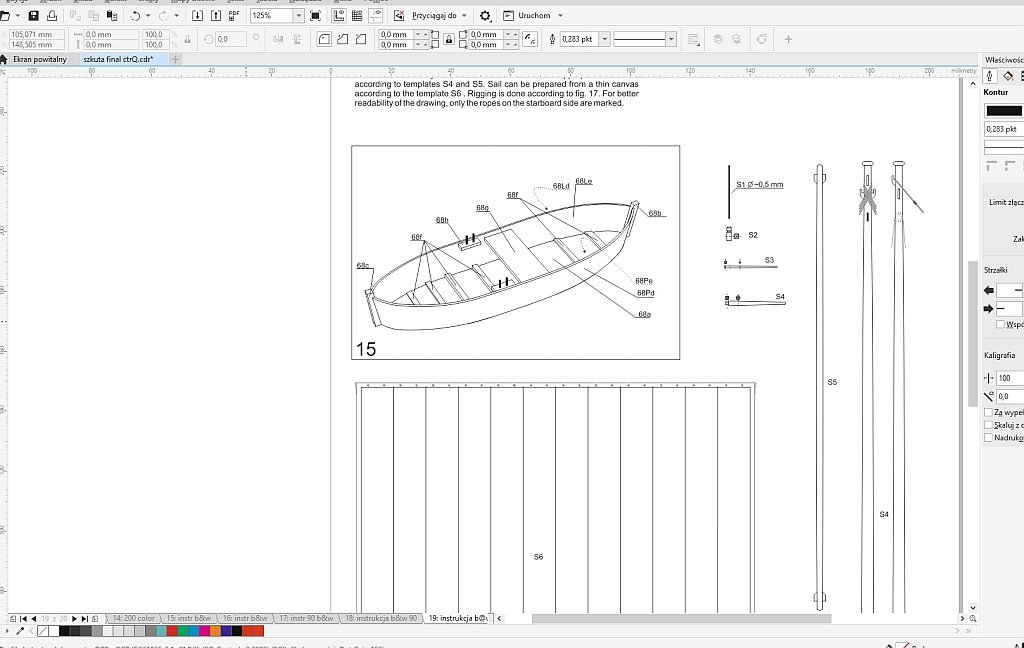
 modelshipworld.com
modelshipworld.com

 encyklopedia.pwn.pl
encyklopedia.pwn.pl
3. General Data
SZKUTA WISLANA
Country: Vistula River, Poland
Type: Barge
Function: Transport
Length: 38.50 m (385 mm)
Beam: 9.90 m (99 mm)
Draft: 1.55 m (15 mm)
Overall Length: 48.70 m (487 mm)
Overall Height: 21.60 m (216 mm)
Scale: 1:100
4. Model Preparation
I took the idea and information from the 1985-1989 Modelarz magazine, but unlike other elaborate models, no frame plan or false keel was made. In this case, I laser-printed the bottom of the vessel (which is flat) as well as the 1/100 scale plans of the floor plan and elevation. I used all the available information, which I include in the references, where there are photos of the model in the Polish Maritime Museum.
On the flat bottom, I began placing 2x3 mm horizontal frames and then the hull reinforcements, which had a 53-to-60-degree slope. Since the strakes had to be installed later, all these frames were reinforced internally to maintain the desired shape as much as possible. The 4x5 mm keel was placed in the center, but since it wouldn't be visible at the stern, I extended it to the transom. It was important to note that, although the bottom is mostly flat, approximately 50 mm before the bow and stern, the bottom level rises by about 6 mm. This was achieved with temporary reinforcements.
We began with the longitudinal and side panels (veneered to simulate vertical planking) of the aft cabin; then the roof was built by placing overlapping 0.5 x 5 mm planks. The helmsman's gangway was then built, running the entire width of the ship, and a planking was added across the bottom of the boat to facilitate crew access.
The 200 mm (20 meter) mast rests on the beam in the middle; its position is vertical. There is a reinforcement made up of two curved elements that run from bow to bow and embrace the mast.
An enclosure was prepared between the mast and the bow; I have not been able to determine its purpose, but it is possible for the crew. The rudder is very special. It's a little over a quarter of the boat's length, measuring 9 meters, and is operated by the helmsman using a very long tiller, over 13 meters long.
Aside from the material storage, I'm faced with the dilemma of (a) leaving the ship empty, or (b) filling the boat with bulk cargo, barrels, packages, etc.
Another issue that worries me is that I've used a lot of cyanoacrylates, and it's leaking out in several areas. So, if I apply a dye, the stains will be noticeable, and it won't look good.
I finished making the sail tied to its yard, the 9-meter rudder and its 13-meter tiller, the oars, the anchor, a bulk cargo tank (I simulated cargo there with its protective tarpaulin), I added a barrel I had lying around, and I completed the bitts and the bow winch.
And yes, after staining the wood with a honey tone, I still had several spots with stains, but a little paint softens those mistakes.
I started to assemble the shrouds, then the sail, the forestay, and finally the sail's maneuvers. I crossed a rope so the tiller wouldn't move, and I think that's it.
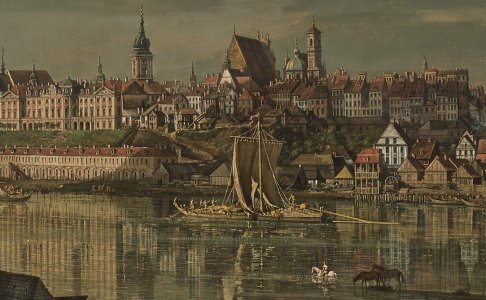
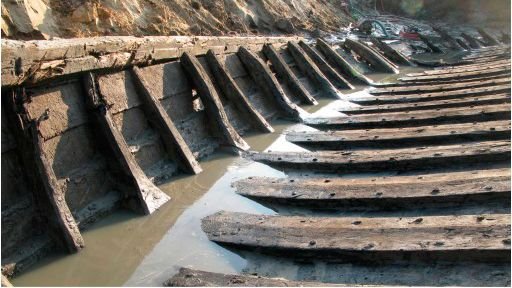
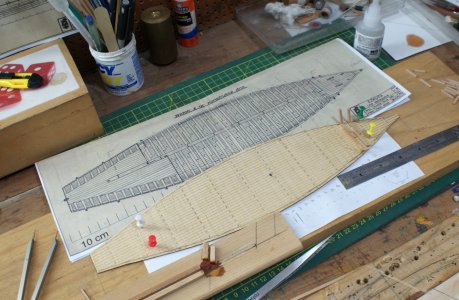
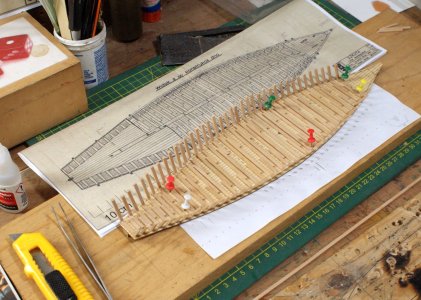
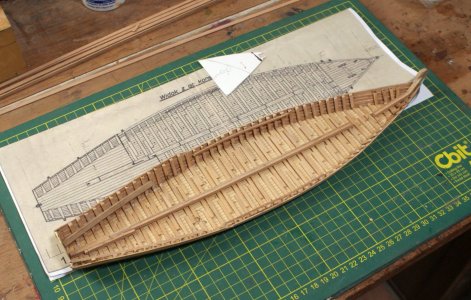
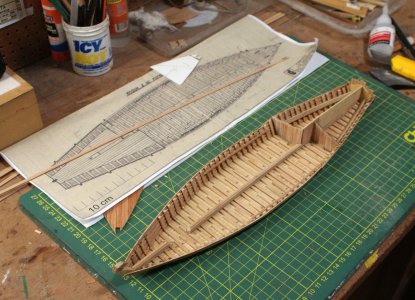
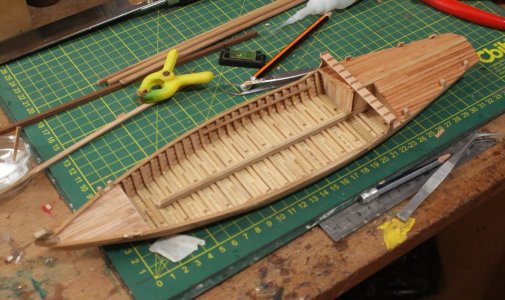
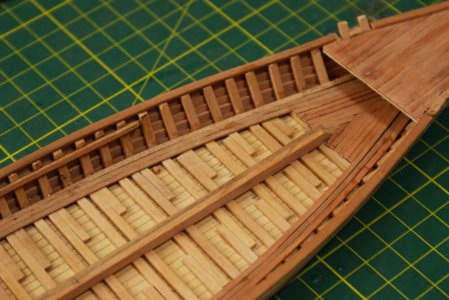
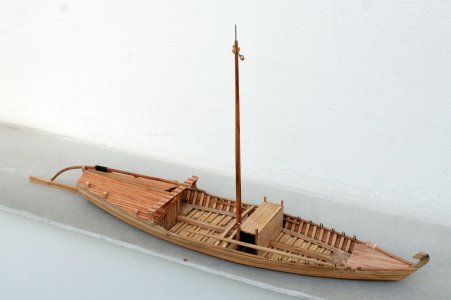
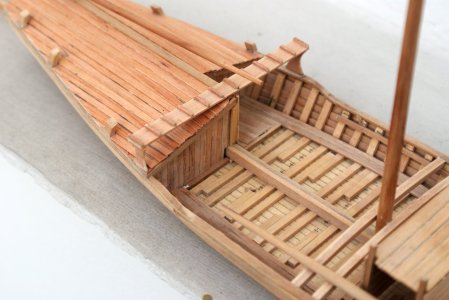
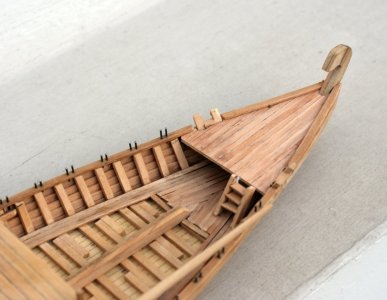
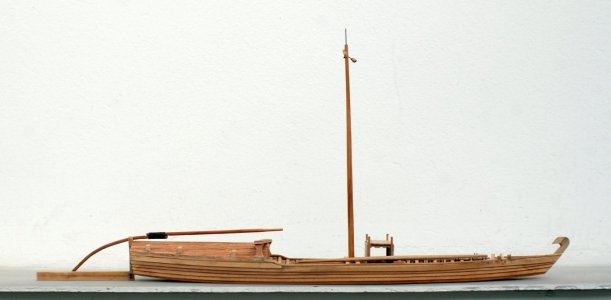
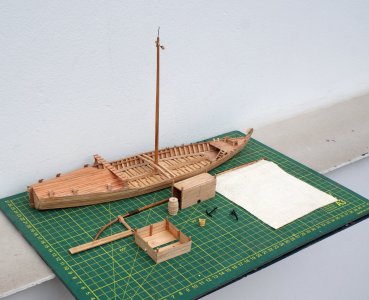
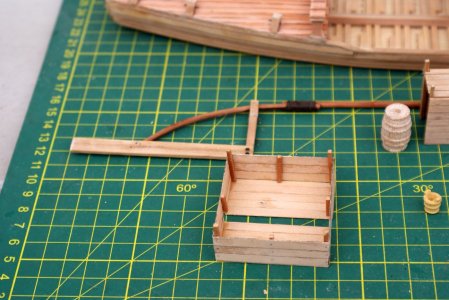
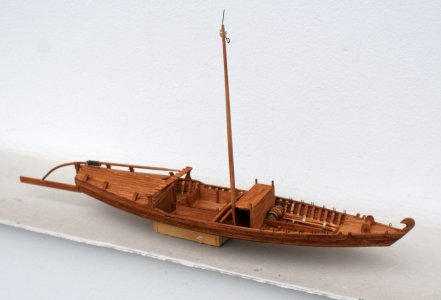
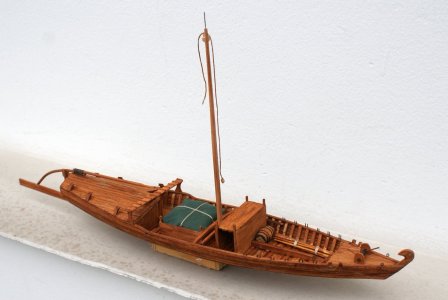
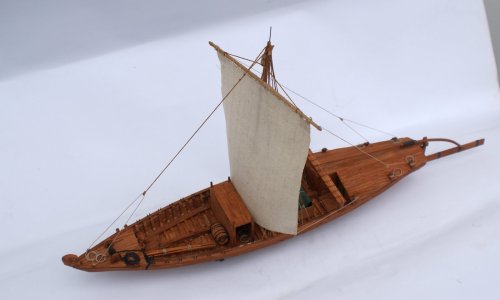
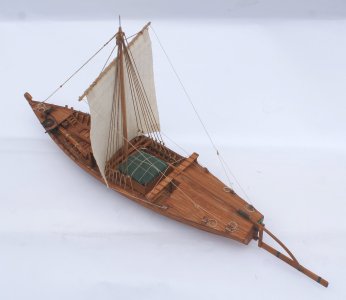
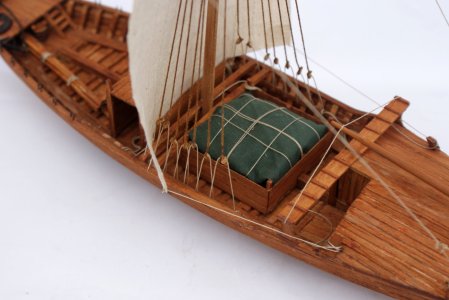
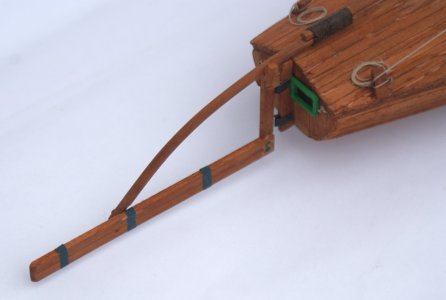
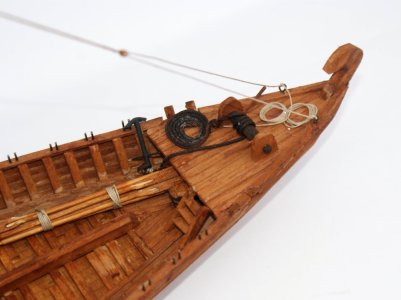
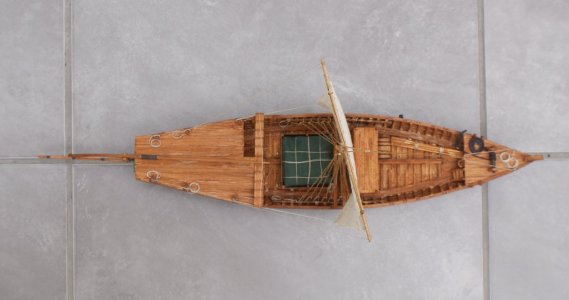
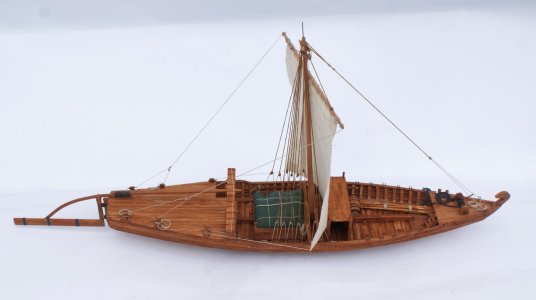
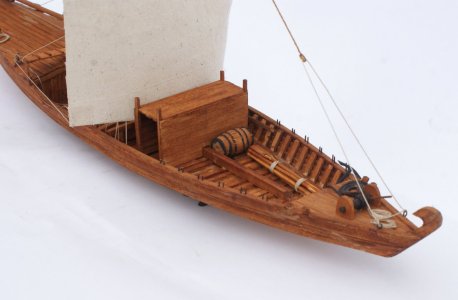
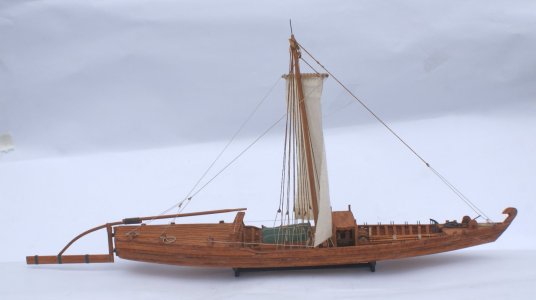
Or also known as the "Vistula Barge," these were large sailing and rowing boats. From the 13th to the 18th century, they were used to transport various cargo and grain along the Vistula to Gdansk. The grain was simply poured into large boxes attached to the deck, and the barge took advantage of the wind and the river's current. The paragraphs in quotation marks correspond to the article “Szkuta Wislana - Marek Zuzanski – Modelarz 1985-12”
1 History
“The barge,” as stated by the PWN Encyclopedia, “is the oldest Polish sailing boat: undecked, with sail and oar, with a very high bow and a flat stern. It can be added that it is the best described and documented Polish sailing vessel. Images of the barge can be found in many engravings and paintings depicting Polish ports in the 17th and 18th centuries. The most beautiful barges, depicted down to the smallest detail, can be seen in Schuster's engraving of 1770 and in Canaletto's painting entitled "View of Warsaw from the Prague Side," also from 1770. However, the main document that allows us to reconstruct the shape, construction, and equipment of Polish riverboats is the 1796 report by Losy von Losennau. It is an inventory of vessels containing drawings. technicians, tabular lists of unit dimensions, materials used for their construction and equipment.
The Szkuta sailed up the Vistula until the end of the 18th century. They transported various goods: barrels, crates, and timber, and after assembling special crates, they also carried bulk cargo: grain or copper ore. Statistics show that 72 percent of the ships sailing to Gdańsk between 1766 and 1770 were barges. In the first half of the 19th century, the barge was dethroned by a new type of boat: the Statku, which was more maneuverable and economical.
After the date of that article, the wreck of a Szkuta was found near Czersk in Mazovia, and thanks to the 2009 excavations, we know a lot about its construction. It consisted of a large, well-preserved barge from the 15th century. The hull was about 30 m long, 7.4 m wide, 1.45 m deep, and had a 21 m mast. It was made of oak wood, with a flat bottom and no keel. The oak strakes were 7 cm thick and 34 to 48 cm wide, bound and sealed with moss and strips of animal hair mixed with tar. Dendrochronological analysis shows that the oak used for the construction of this boat was fell in the second half of the 15th century and that the Czersk barge sailed on the Vistula for at least 60 years old. Very similar to the boat shown here. It's worth mentioning that in addition to the skipper and helmsman, this boat required up to 16 crew members to row or pull it upstream along paths, sometimes assisted by oxen or similar means.
2. References:

Jachty niezwykłe: WIŚLANA BARKA
Kiedy w marcu 2012 roku w wiślanym Porcie Praskim w Warszawie spłonęła zabytkowa barka, zasmuciłem się podwójnie. Nieodwracalnie znikł pomnik dawnej świetności ...

Szkuta – Wikipedia, wolna encyklopedia

Szkuta czerska – Wikipedia, wolna encyklopedia

Szkuta wiślana (Vistula barge) by 0Seahorse - FINISHED - 1:100 - CARD - XV-XVIII century
Hello Waiting for the cooperators until they meet what they promised for my "7 Provinces" I decided to rest for a while and started something simpler (but not much smaller). The "szkutas" sailed on the Vistula for several centuries, transporting mainly grain to Gdańsk. They were really huge, beca...
 modelshipworld.com
modelshipworld.com
Tartak Witkowscy - Tartak i Zakład Stolarski - Szkuta Wanda
Jesteśmy wiądącą firmą w kraju wykonującą gotowe prefabrykowane konstrukcje drewniane.Doradzamy,projektujemy i montujemy więźby dachowe,wiązary dachowe łączone płytką wielokolcową
www.wiazar.pl

szkuta, informacje z Encyklopedii PWN: źródło wiarygodnej i rzetelnej wiedzy
szkuta - Encyklopedia PWN
3. General Data
SZKUTA WISLANA
Country: Vistula River, Poland
Type: Barge
Function: Transport
Length: 38.50 m (385 mm)
Beam: 9.90 m (99 mm)
Draft: 1.55 m (15 mm)
Overall Length: 48.70 m (487 mm)
Overall Height: 21.60 m (216 mm)
Scale: 1:100
4. Model Preparation
I took the idea and information from the 1985-1989 Modelarz magazine, but unlike other elaborate models, no frame plan or false keel was made. In this case, I laser-printed the bottom of the vessel (which is flat) as well as the 1/100 scale plans of the floor plan and elevation. I used all the available information, which I include in the references, where there are photos of the model in the Polish Maritime Museum.
On the flat bottom, I began placing 2x3 mm horizontal frames and then the hull reinforcements, which had a 53-to-60-degree slope. Since the strakes had to be installed later, all these frames were reinforced internally to maintain the desired shape as much as possible. The 4x5 mm keel was placed in the center, but since it wouldn't be visible at the stern, I extended it to the transom. It was important to note that, although the bottom is mostly flat, approximately 50 mm before the bow and stern, the bottom level rises by about 6 mm. This was achieved with temporary reinforcements.
We began with the longitudinal and side panels (veneered to simulate vertical planking) of the aft cabin; then the roof was built by placing overlapping 0.5 x 5 mm planks. The helmsman's gangway was then built, running the entire width of the ship, and a planking was added across the bottom of the boat to facilitate crew access.
The 200 mm (20 meter) mast rests on the beam in the middle; its position is vertical. There is a reinforcement made up of two curved elements that run from bow to bow and embrace the mast.
An enclosure was prepared between the mast and the bow; I have not been able to determine its purpose, but it is possible for the crew. The rudder is very special. It's a little over a quarter of the boat's length, measuring 9 meters, and is operated by the helmsman using a very long tiller, over 13 meters long.
Aside from the material storage, I'm faced with the dilemma of (a) leaving the ship empty, or (b) filling the boat with bulk cargo, barrels, packages, etc.
Another issue that worries me is that I've used a lot of cyanoacrylates, and it's leaking out in several areas. So, if I apply a dye, the stains will be noticeable, and it won't look good.
I finished making the sail tied to its yard, the 9-meter rudder and its 13-meter tiller, the oars, the anchor, a bulk cargo tank (I simulated cargo there with its protective tarpaulin), I added a barrel I had lying around, and I completed the bitts and the bow winch.
And yes, after staining the wood with a honey tone, I still had several spots with stains, but a little paint softens those mistakes.
I started to assemble the shrouds, then the sail, the forestay, and finally the sail's maneuvers. I crossed a rope so the tiller wouldn't move, and I think that's it.



























